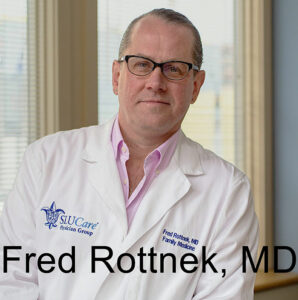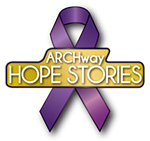Fred Rottnek, MD, MAHCM
Stories of Hope
ARCHway believes in recovery from the disease of addiction.
 Dr. Rottnek speaks on his work in Addiction Medicine and his involvement with the ARCHway Institute
Dr. Rottnek speaks on his work in Addiction Medicine and his involvement with the ARCHway Institute
Interviewed by Emily Jung
View the interview video at the bottom of this page.
Dr. Rottnek is a Professor and the Director of Community Medicine at Saint Louis University (SLU) School of Medicine and the Medical Director of the Physician Assistant Program.
He is a graduate of the Saint Louis University School of Medicine and the Master of Arts in Health Care Mission Program at Aquinas Institute of Theology. His clinical practices have included correctional healthcare, homeless healthcare, community clinics, and addiction medicine. He teaches in the School of Medicine, the PA Program, Interprofessional Education Program, and the Center for Health Law Studies. Board-Certified in Family Medicine and Addiction Medicine, he is the Medical Director for the Assisted Recovery Centers of American (ARCA).
Dr. Rottnek is the Program Director of the Saint Louis University Addiction Medicine Fellowship. He serves on the boards of the Saint Louis Regional Health Commission, Alive and Well Communities, and the ARCHway Institute.
Personal Struggles with Mental Health
Dr. Rottnek had many life events that led him to where he is today. One of these includes his own personal struggles with mental health. He said, “I had major depression growing up through high school, through college. I took many detours in my medieval years, as I call them, between college and medical school, and that also involved two major depressive episodes.”
Dr. Rottnek was able to overcome these struggles, and they would propel him into a career he finds much purpose in today. He said, “Once I got better personally…once I got engaged in the healing process…I thought to myself, what do I want to do with myself and my career?”
Through the healing process, Dr. Rottnek developed new coping mechanisms, new techniques and new ways of thinking that he could share. It also became important to him to begin his education in medicine. Along the way, he saw different barriers in the medical system preventing people from getting well.
He said, “I knew I wanted to incorporate my values, and I also knew that I wanted to care for an underserved environment. I got involved in homeless healthcare as a med student. And then in residency, I continued that work.”
His personal struggles started him on this path, and through opportunities that have arisen for him and through further education and awareness, he is now working to help those struggling with mental health and substance use disorders.
His Path as a Healthcare Provider
 From his start in homeless healthcare, Dr. Rottnek made his way to correctional healthcare and spent 15 1/2 years as the lead physician at the Saint Louis County Jail and Juvenile Detention at Family Courts. Over the years, he developed an understanding of the role of addiction in both homelessness and criminal justice. Addiction rates were and still are high in these populations.
From his start in homeless healthcare, Dr. Rottnek made his way to correctional healthcare and spent 15 1/2 years as the lead physician at the Saint Louis County Jail and Juvenile Detention at Family Courts. Over the years, he developed an understanding of the role of addiction in both homelessness and criminal justice. Addiction rates were and still are high in these populations.
Dr. Rottnek says, “Addiction is a key element of why people become homeless, of how homeless folks cope with their state. Same thing in correctional healthcare. It’s estimated that 80 to 90 percent of people in a criminal justice setting have an active or inactive substance use disorder.”
So, with 20 years of experience working with individuals, families and communities that addiction is a part of, his focus began to change to addiction medicine, finding it as one of the root causes to the other issues he was so passionate about.
Today, Dr. Rottnek is a Professor and the Director of Community Medicine and the Medical Director of the Physician Assistant Program at Saint Louis University (SLU) School of Medicine. He believes in the education of young people in the area of addiction medicine. To him, it is about helping them grow in understanding and awareness of the disease and the science for treating the disease. He grows a pipeline of like-minded students and other health professionals that can help to get people struggling with substance use and mental health disorders get the assistance they need to recover and stay well.
Dr. Rottnek also works as the Medical Director of the Assisted Recovery Centers of America (ARCA), where he strives to standardize treatment in addiction medicine. He said there are currently not enough clear guidelines for the medications used to treat Opioid Use Disorder (OUD).
Questions arise: Which medication is best for the patient? How long should a patient continue on this medication? What dosage should they be taking? When should they taper and perhaps transition to another treatment? Medications like Suboxone, Subutex, and Methadone are controlled substances; how do we use these drugs to properly care for our patients while keeping them safe?
Dr. Rottnek strives to standardize treatment and teach best practices in the integration of these medications for treatment of substance use and opioid use disorder. He does this through his work at SLU and ARCA, and also as part of the State Opioid Response Team and other boards on which he sits. One of those is the ARCHway Institute. As one of their newest board members, the ARCHway board is grateful for his guidance in the area of addiction medicine!
The Current Opioid Epidemic: How We Got Here and How We are Changing It
We know that the current opioid epidemic did not happen by accident. There were several contributing factors. Dr. Rottnek shared, “The current opioid epidemic is a bit of the perfect storm of a lot of things happening all at one time. One was the development of semi-synthetic opioids which were originally development only for use in hospitals. But marketing these medications changed in the early 90’s. These meds were being promoted for use in outpatient settings, which had never been the case before.” This was one way opioids were brought into the home.
This was accompanied by the development of the pain scale (rate your pain on a scale from one to ten). Dr. Rottnek said, “Pain scales can be useful if you’re talking about a specific intervention and reporting whether your pain is getting better or worse. But what happened was that we arbitrarily came up with these numbers, that if your pain was above a level three, it wasn’t being managed well. And when it’s not being well managed, we have to do something else – something more – oftentimes that leads to higher dosages of medication.”
“Pain is part of the human experience,” as Dr. Rottnek put it. “A certain level of it is commonplace in certain life situations. We cannot get rid of all pain at all times.”
Dr. Rottnek added, “On top of that, insurance companies started reimbursing based on surveys about where a patient’s pain scale was. Many incentives, with unintended consequences, promoted liberal dosing of chronic opioids. In recent decades, consider the additional almost-limitless supply of extremely high potency opioids by overnight delivery, the connectedness and immediacy made available by smartphones, social media and the dark web; and we had a perfect storm of where we are today.”
Although we’ve created this perfect storm, we do have the ability to rethink and restructure how we treat pain and prescribe opioids. Dr. Rottnek believes that it involves having “more specific evidence-given guidelines around use of opioids for acute pain [and] for exacerbation or worsening of chronic pain.”
He added, “we are going back to what was used–and what worked– in the past like Ibuprofen, Tylenol, cold, and heat, and we are focusing on function rather than on the pain scale. This means we need to help people identify what their pain is preventing them from doing and finding other ways to help them do those things.”
A lot of Dr. Rottnek’s time when educating his students and other healthcare providers is spent on ‘How do we get back to basics on pain? How do we incorporate other specialists and health professions that provide non-pharmaceutical approaches to pain management?’
And he adds, “We also have to be careful about the overcorrection that has been happening in prescribing practices. Some physicians in particular are just not prescribing opioids any more. That’s not responsible either. There is an appropriate role for opioids. We just have to get back to evidence-based practices and prescribing.”
Barriers and Possible Solutions
 Dr. Rottnek has worked with clients suffering from addiction and mental health disorders for long enough that he has developed an awareness of the barriers patients face in getting treatment and truly thriving in recovery.
Dr. Rottnek has worked with clients suffering from addiction and mental health disorders for long enough that he has developed an awareness of the barriers patients face in getting treatment and truly thriving in recovery.
Individuals and families need to know where to go. More providers need to work in addiction medicine. And there needs to be more resources available to those without insurance.
Overall, Dr. Rottnek says, “We do not have enough people doing this care and we do not have enough of this care integrated into routine health in the U.S.”
He also explains that, when compared to other chronic disease states, substance use disorders lacks research and evidence-based practices. “Unfortunately in the U.S., we tend to research people and populations that we value. In my experience and in my clinical work with the homeless, with correctional healthcare, and now with addiction, we traditionally have not valued people with substance use disorders.”
One of the game-changers with the current opioid epidemic is that it is an equal opportunity killer. More people from different socioeconomic groups are being affected.
Although it’s unfortunate that it has had to reach this level of severity to wreak havoc and get people to listen, we are now seeing more funding being put into the opioid epidemic. Dr. Rottnek explains that we need to be putting some of this funding towards establishing programs centered around the research and best practices in addiction medicine.
Harm Reduction is Necessary but It’s Also Not Sufficient
With this in mind, Dr. Rottnek explains some of the techniques he sees as Best Practices. These are things we can continue to fund and develop research around. Dr. Rottnek teaches that harm reduction tactics like Narcan distribution are good things because they keep people alive. However, he also says, “Harm reduction is necessary but it is not sufficient. Keeping people alive is not the same as helping people thrive.”
Harm reduction cannot be the only tactic used or that which we fund because there is more to recovery than simply staying alive. Once we’ve used harm reduction to engage someone in treatment, we have to standardize the techniques to keep that person there and help him or her thrive.
From Dr. Rottnek, “Unfortunately, the standards of treatment successes internationally have traditionally been retention in treatment. Keep somebody coming back; if they’re alive, their treatment is working. Well, that bar is set so low we’re tripping over it. That is not the bar of success when we’re talking about treating folks with diabetes, with obesity, with hypertension, with cardiovascular disease. What we need to do in the U.S. is to really focus on how to move people to thriving.”
Thriving in Recovery looks like: relationships being restored, holding a job and enjoying that job, finding passion and purpose in what you do, and being able to provide for yourself and your family if necessary, as well as working through mental health disorders and trauma.
We want to look at the overall health of the individual, including their mental health and their social, economic, and behavioral barriers to living a happy, joyous, and free life.
Focus on Patient-Centered Care
So, how do we help people achieve a state of thriving? We focus on patient-centered care and what works best for the individual. Every individual responds differently to the different medications available to treat substance use disorder. We must take this into account.
Dr. Rottnek says, “Right now in the U.S., we have a lot of unnecessary squabbling about the three medications available to treat opioid use disorder. There is a role for Methadone, there is a role for Buprenorphine, and there is a role for Naltrexone. Rather than arguing about which is best, what we need to be talking to each other about what is the best medication for where a person is in recovery. And I think if we change that conversation, it’s going to change the idea of having a one-size-fits-all approach to substance use disorders, particularly opioid use disorder, how we manage this disease, and work with patients successfully, like we do with every other chronic disease.”
We need to join together to discuss which medication may be the best choice for the person at that person’s point in recovery and level of thriving.
Thoughts on the Criminal Justice System
After his experience in the criminal justice system, Dr. Rottnek knows that some of the barriers to recovery occur in jails and prisons. Substance users are overrepresented throughout the criminal justice system. Dr. Rottnek explained some of the techniques that have worked and how they will continue to decrease incarceration rates, especially for repeat offenders due to substance abuse and mental health.
Dr. Rottnek shared that incarceration rates started coming down in 2009-10 because of a few things, including the introduction of substance use and mental health treatment courts. He says, “It’s a way to keep people out of prisons and help them get into systems of care so that if these situations [substance use and mental health disorders] were driving people into the criminal justice realm. Helping get these people appropriately treated would keep them out[of prison].”
Dr. Rottnek also promoted home monitoring for low level offenses and decriminalizing substance use on a small scale. He mentioned the need for education in jail and prison as well.
Overall, we have to look at a jail sentence as an opportunity to intervene. Dr. Rottnek said, “If someone’s in jail and if they can get a thorough behavioral health exam, a thorough substance history, and a diagnosis, there is an opportunity for intervention. If these folks are interested in treatment, they can be started on medications and participate in a warm hand-off to a community, which increases the likelihood that people will do better and will be less likely to come back into the system.”
This stabilization may also include the use of a peer support specialist; someone who has been there and done that, someone with the experience and the connection to resources and services. This peer may also help get the individual connected back to their treatment agency while incarcerated and work to develop an aftercare plan, during which the peer can stay connected for as long as needed.
Says Dr. Rottnek, “Let’s see that time in jail is not to punish somebody as much as it is a chance to intervene and reconnect.” If more money were invested in these prevention strategies, less money would be invested in the hyperincarceration that we have built for decades.
Involvement in ARCHway Institute
With his knowledge, experience and thought processes around addictive medicine, ARCHway is proud to have Dr. Rottnek as a member of their board of directors. Dr. Rottnek is excited to help fulfill the ARCHway mission of providing hope and knocking down barriers to recovery for individuals and families.
Dr. Rottnek believes that ARCHway is more than the events and fundraising. ARCHway is striving to develop peer support specialists, who he sees as vital to the recovery process. He says, “What I have learned very quickly in this field is that the magic happens with the peer support specialists. The medication is necessary, but it’s not sufficient. It’s not enough to get people to the point of thriving and well-being. The magic happens when you can establish trust and rapport with somebody seeking treatment. And who better to do that than a peer?”
One way that ARCHway Insitute is promoting peers is through their work with Saint Louis University (SLU). ARCHway is involved in a HRSA grant that was awarded to SLU in 2019. This funding has allowed ARCHway peers to learn alongside medical family therapy students. It not only allows peers the opportunity to learn and grow in their work with their own clients, it allows SLU students to have a better understanding of the realities of addiction. Moreover, it starts conversations between peers and clinicians early on, creating better future relationships between all members of a treatment team.
This grant will span three years. When asked about the possible results, Dr. Rottnek predicts only positive outcomes for both healthcare providers and the future of certified peer specialists. He feels the grant will lead to “Three years of highly successful, team-based care that will introduce and perhaps integrate peers into addiction medicine treatment. I want to demonstrate to healthcare systems like Mercy and SSM the value that peers can bring to team-based care around addiction work.”
Dr. Rottnek has seen peers change the lives of their clients, but it is more than that. There is research or evidence around the use of peers in the treatment team. Dr. Rottnek said, “We have known through many studies and many policies that peers are instrumental in creating positive patient outcomes and safe patient outcomes in not only substance use disorder but also for folks with chronic pain and folks with serious mental illness.”
This also means that peers need to be compensated fairly for the work they are doing, and they need to be seen as equal in importance to the rest of the treatment team. Dr. Rottnek says, “I think what we need to do is step up so we eventually hard dollars these positions into our budgets. But then, we also need to change reimbursement structures so that medicare, medicaid and private insurance all recognize the value of this team and the value of a peer support role.”
In addition to working more closely with peers through ARCHway, Dr. Rottnek sees the organization continuing to grow. He says, “ARCHway has already established a national presence in several states, and in a way that has humanized and normalized the discussion of substance use disorders. The folks, the pioneers in ARCHway, have been able to enter communities through family members, through connections, to have conversations where conversations have not been had before.”
ARCHway started in St. Louis and spread to areas where the team was most familiar and/or where the representatives were living, such as Florida and Ohio.
However, the organization has now expanded to nine different states, where it continues to open up conversation and dialogue around this disease. Dr. Rottnek says, “ARCHway has formed solid working relationships with other organizations that demonstrate excellence in complementary areas around substance use disorders,” and he knows they will continue to do this in additional states and communities.
“I would love to see those of us with ARCHway take that model of collaboration to other states. Other states probably have something like this going on, so let’s see if we can take the lessons we’ve learned, put them together with the lessons other states are learning, and come up with ways of building long-term relationships that are highly effective.”
ARCHway Institute is a community of hope, working to spread awareness and education, connect people to resources, and provide funding that knocks down barriers to those on their path to recovery. The organization does this with their dedicated board members, and network of providers, treatment agencies and resources, and community members.
ARCHway is able to develop relationships because all involved DO have a common goal of decreasing overdose deaths and preventing substance use. Without working together, this cannot happen. It is ARCHway’s mission to continue to cultivate these relationships, as Dr. Rottnek suggests.
Dr. Rottnek leaves us with this: “I’ve seen tremendous progress just in my lifetime around areas of criminal justice, about acknowledging homelessness, about conversations around substance use disorders. I see this as moving forward”
“I think we’ve taken the lid off of this discussion. So let’s move forward as collaboratively as we can, let’s spotlight what we know works well, let’s pursue more evidence around research questions, and let’s get our peers out there. I believe ARCHway is going to be a tremendous venue to connect these different stakeholders moving forward.”
For more information about ARCHway Institute for Addictive Disease and Co-Existing Mental Health Disorders, contact:
ARCHway Institute for Addictive Diseases and Co-existing Mental Health Disorders
3941 Tamiami Trail Suite 3157-53, Punta Gorda, Florida 33950
Email: Emily.Jung@TheARCHwayInstitute.org
Phone: 314-635-8887
Website: https://TheArchwayInstitute.org/
Facebook: https://www.Facebook.com/TheArchwayinstitute/
Vimeo VOD: https://Vimeo.com/ondemand/archwaystoriesofhope

